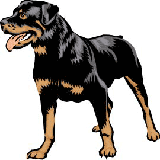Big DogsHow To Keep Large Breed Puppies In Shape |
|
|
Once your puppy has finished his set of shots, he is now ready to be taken out for his exercise. However, keep in mind that you should not take him out for long, strenuous walks until he is about six months old. Once he has reached six months of age, then he will be truly ready to get his regular exercise. Regular exercise helps in essential bone and soft tissue development in big puppies as well as older dogs. It minimizes the effect of arthritis and aging of tissues. Exercise is also important for all ages and sizes of dogs in order for them to remain healthy and happy. Regular exercise also aids in successful puppy training, bonding, and production of strong bones and muscles. And similar to humans, giving your puppy his regular exercise will also improve his overall thinking ability, attitude, experience, and also enhances his problem-solving ability. Providing your large dog puppy adequate amount of exercise is mandatory. As a general rule, a good twenty minutes of walk twice a day, preferably one in the morning and one at night, should be sufficient for a large dog puppy. On some occasions when you cannot fulfill this obligation, the puppy can be exercised by retrieving a ball or some other object in the yard, but games should not become a substitute for daily walks. The large, energetic puppy that is shut up for many hours and not given sufficient amount of exercise is likely to become a bored and even destructive one. When giving your puppy his exercise, keep in mind that too much of it can be harmful to your growing big dog. When he plays and exercises vigorously before his bones, cartilage, ligaments, and tendons have fully developed, these structures are often injured. Injuries will not necessarily relate to external trauma, but rather to the immaturity of tendons, ligaments, cartilage, and bone when subjected to the weight of a fast-growing large breed. Before you progress from one type of exercise to another, or longer sessions of exercise, evaluate your puppy's development, his strength, his coordination, and his overall size and weight. You may also consult your vet or breeder for further advise. Always supervise your puppy during his exercise. Safe exercises for a large puppy includes the following: Controlled walks on a leash, controlled swimming, and simple games of hide-and-seek. Avoid activities that require running with sudden stops, pivoting on hind legs, jumping, and roughhousing.Back to the Big Dog Breed article page
| |
|
Related News About Dogs ' ); // get rid of newsfeed display by carp CarpConf('poweredby',''); CarpCacheShow('http://classifieds.agriscape.com/syndicate/dogs.rss'); ?>
|
|
|
|
|
|
Copyright © 2006-2007 dogguidance.com |


